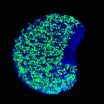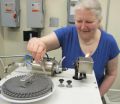(Press-News.org) CAMBRIDGE, Mass. (May 29, 2014) – In any animal's lifecycle, the shift from egg cell to embryo is a critical juncture. This transition represents the formal initiation of development—a remarkably dynamic process that ultimately transforms a differentiated, committed oocyte to a totipotent cell capable of giving rise to any cell type in the body.
Induction of totipotency (as well as the pluripotency characteristic of embryonic stem cells) requires dramatic changes in gene expression. To date, investigations of such changes have largely focused on transcription, when DNA strands are copied into the messenger RNA (mRNA) that is subsequently translated to produce the proteins essential for proper cellular function. Yet, as Whitehead Institute Member Terry Orr-Weaver is quick to remind, at this crucial moment in life, transcription is absent.
"At the start of development, there are mechanisms other than transcription for restoring potency." Orr-Weaver says. "There are massive changes in translation accompanying the onset of development."
Recognizing the importance of translation, Orr-Weaver and her lab set out to document these "massive changes"—and their regulators—in what would be an equally massive, nearly four-year undertaking. The lab conducted perhaps the most comprehensive look yet at changes in translation and protein synthesis during a developmental change, using the oocyte-to-embryo transition in Drosophila as a model system. En route, the researchers, whose results are reported this week in the journal Cell Reports, deployed three sophisticated analytical techniques: global polysome profiling to measure active translation for thousands of mRNAs; ribosome footprint profiling to determine how efficiently each mRNA is being translated; and quantitative mass spectrometry to measure changes in protein levels at the oocyte-to-embryo transition.
"This is the first time all three pieces have been put together," Orr-Weaver says. "This comprehensive approach was crucial for gathering the insights we did."
Among those insights is the surprisingly large number of mRNAs that are translationally regulated. Approximately one thousand mRNAs were found to be upregulated, with several hundred more downregulated during this transition. Another surprise is the emergence of the protein kinase complex known as PNG as a major regulator of the observed translational changes. In earlier work, the Orr-Weaver lab had shown that the PNG kinase is necessary for the initiation of mitosis in a fertilized embryo (as opposed to the meiosis that occurs in oocytes prior to egg activation) by promoting the synthesis of Cyclin B, which is required for entry into mitosis. Subsequent work suggested that the PNG kinase's regulatory effects might be limited to activating translation of a small number of targets. This latest research, however, finds PNG acting globally, affecting translation both positively and negatively.
"For me this was unexpected," says Iva Kronja, a postdoctoral researcher in the Orr-Weaver lab and first author of the Cell Reports paper. "We knew of three mRNAs that were regulated by PNG, but these results suggest that at the oocyte-to-embryo transition, PNG controls translational status of at least 60% of translationally activated and perhaps 70% of translationally inhibited mRNAs."
Both Kronja and Orr-Weaver say this key finding shows the value of studying translation globally to record what is referred to as the "translatome". Yet the translatome provides only part of the picture. The rest is revealed through quantitative analysis of changes in the protein levels that shape the proteome. Here, too, a few surprises emerged.
The scientists discovered a set of roughly 60 mRNAs whose translation was upregulated without a corresponding increase in the levels of protein produced. This apparent paradox suggests that at the oocyte-to-embryo transition, protein degradation is occurring simultaneously with translational activation. Such compensation could maintain overall protein levels while "resetting" the proteome at restoration of totipotency, delivering proteins in a form that is optimal for embryogenesis. Kronja believes there's a quality-control aspect to this balancing act.
"I see this process as preparation for a dynamic and intense period of development," says Kronja. "Its purpose may be making sure that the right components with the right modifications are in place for embryonic development."
Orr-Weaver notes that this latest work has opened a number of new research avenues for her lab, including trying to determine whether previously unidentified proteins are regulating the switch from meiosis to mitosis at this key transitional moment.
"We found new proteins whose function has been unknown," says Orr-Weaver. "But from the dynamic changes in their levels that we observed, they may be candidates that are responsible for flipping that switch."
INFORMATION:
This work was supported by the National Institutes of Health (grant GM39341), the American Cancer Society, and the Alexander von Humboldt Foundation.
Written by Matt Fearer
Terry Orr-Weaver's primary affiliation is with Whitehead Institute for Biomedical Research, where her laboratory is located and all her research is conducted. She is also an American Cancer Society Research Professor of biology at Massachusetts Institute of Technology.
Full Citation:
"Widespread changes in the posttranscriptional landscape at the Drosophila oocyte-to-embryo transition"
Cell Reports, May 29, 2014
Iva Kronja (1), Bingbing Yuan (1), Stephen Eichhorn (1,2,3), Kristina Dzeyk (4), Jeroen Krijgsveld (4), David P. Bartel (1,2,3), and Terry L. Orr-Weaver (1,2)
1. Whitehead Institute for Biomedical Research, Nine Cambridge Center, Cambridge, MA 02142, USA
2. Department of Biology, Massachusetts Institute of Technology, 77 Massachusetts Avenue, Cambridge, MA 02142, USA
3. Howard Hughes Medical Institute, Massachusetts Institute of Technology, 77 Massachusetts Avenue, Cambridge, MA 02142, USA
4. European Molecular Biology Laboratory, 69117 Heidelberg, Germany
Lost in translation?
Not when it comes to control of gene expression during Drosophila development
2014-05-29
ELSE PRESS RELEASES FROM THIS DATE:
There's more than one way to silence a cricket
2014-05-29
For most of us, crickets are probably most recognizable by the distinctive chirping sounds males make with their wings to lure females. But some crickets living on the islands of Hawaii have effectively lost their instruments and don't make their music anymore. Now researchers report in the Cell Press journal Current Biology on May 29 that crickets living on different islands quieted their wings in different ways at almost the same time.
"There is more than one way to silence a cricket," says Nathan Bailey of the University of St Andrews. "Evolution by natural selection ...
Melanoma of the eye caused by 2 gene mutations
2014-05-29
Researchers at the University of California, San Diego School of Medicine have identified a therapeutic target for treating the most common form of eye cancer in adults. They have also, in experiments with mice, been able to slow eye tumor growth with an existing FDA-approved drug.
The findings are published online in the May 29 issue of the journal Cancer Cell.
"The beauty of our study is its simplicity," said Kun-Liang Guan, PhD, professor of pharmacology at UC San Diego Moores Cancer Center and co-author of the study. "The genetics of this cancer are very simple ...
'Free choice' in primates altered through brain stimulation
2014-05-29
When electrical pulses are applied to the ventral tegmental area of their brain, macaques presented with two images change their preference from one image to the other. The study by researchers Wim Vanduffel and John Arsenault, KU Leuven and Massachusetts General Hospital, is the first to confirm a causal link between activity in the ventral tegmental area and choice behavior in primates.
The ventral tegmental area is located in the midbrain and helps regulate learning and reinforcement in the brain's reward system. It produces dopamine, a neurotransmitter that plays an ...
Activation of brain region can change a monkey's choice
2014-05-29
Artificially stimulating a brain region believed to play a key role in learning, reward and motivation induced monkeys to change which of two images they choose to look at. In experiments reported online in the journal Current Biology, researchers from Massachusetts General Hospital (MGH) and the University of Leuven in Belgium confirm for the first time that stimulation of the ventral tegmental area (VTA) – a group of neurons at the base of the midbrain – can change behavior through activation of the brain's reward system.
"Previous studies had correlated increased ...
Fertility: Sacrificing eggs for the greater good
2014-05-29
Baltimore, MD— A woman's supply of eggs is a precious commodity because only a few hundred mature eggs can be produced throughout her lifetime and each must be as free as possible from genetic damage. Part of egg production involves a winnowing of the egg supply during fetal development, childhood and into adulthood down from a large starting pool. New research by Carnegie's Alex Bortvin and postdoctoral fellow Safia Malki have gained new insights into the earliest stages of egg selection, which may have broad implications for women's health and fertility. The work is reported ...
NASA missions let scientists see moon's dancing tide from orbit
2014-05-29
Scientists combined observations from two NASA missions to check out the moon's lopsided shape and how it changes under Earth's sway – a response not seen from orbit before.
The team drew on studies by NASA's Lunar Reconnaissance Orbiter, which has been investigating the moon since 2009, and by NASA's Gravity Recovery and Interior Laboratory, or GRAIL, mission. Because orbiting spacecraft gathered the data, the scientists were able to take the entire moon into account, not just the side that can be observed from Earth.
"The deformation of the moon due to Earth's pull ...
UNL team explores new approach to HIV vaccine
2014-05-29
Lincoln, Neb., May 29, 2014 -- Using a genetically modified form of the HIV virus, a team of University of Nebraska-Lincoln scientists has developed a promising new approach that could someday lead to a more effective HIV vaccine.
The team, led by chemist Jiantao Guo, virologist Qingsheng Li and synthetic biologist Wei Niu, has successfully tested the novel approach for vaccine development in vitro and has published findings in the international edition of the German journal Angewandte Chemie.
With the new approach, the UNL team is able to use an attenuated -- or weakened ...
A tool to better screen and treat aneurysm patients
2014-05-29
New research by an international consortium, including a researcher from Lawrence Livermore National Laboratory, may help physicians better understand the chronological development of a brain aneurysm.
Using radiocarbon dating to date samples of ruptured and unruptured cerebral aneurysm (CA) tissue, the team, led by neurosurgeon Nima Etminan, found that the main structural constituent and protein – collagen type I – in cerebral aneurysms is distinctly younger than once thought.
The new research helps identify patients more likely to suffer from an aneurysm and embark ...
Gender stereotypes keep women in the out-group
2014-05-29
New Rochelle, NY, May 29, 2014—Women have accounted for half the students in U.S. medical schools for nearly two decades, but as professors, deans, and department chairs in medical schools their numbers still lag far behind those of men. Why long-held gender stereotypes are keeping women from achieving career advancement in academic medicine and what can be done to change the institutional culture are explored in an article in Journal of Women's Health, a peer-reviewed publication from Mary Ann Liebert, Inc., publishers. The article is available free on the Journal of Women's ...
Caught by a hair
2014-05-29
Crime fighters could have a new tool at their disposal following promising research by Queen's professor Diane Beauchemin.
Dr. Beauchemin (Chemistry) and student Lily Huang (MSc'15) have developed a cutting-edge technique to identify human hair. Their test is quicker than DNA analysis techniques currently used by law enforcement. Early sample testing at Queen's produced a 100 per cent success rate.
"My first paper and foray into forensic chemistry was developing a method of identifying paint that could help solve hit and run cases," explains Dr. Beauchemin. "Last year, ...
LAST 30 PRESS RELEASES:
New study shows how the spleen helps the immune system accept a transplant
New Mayo Clinic study advances personalized prostate cancer education with an EHR-integrated AI agent
Researchers identify novel therapeutic target to improve recovery after nerve injury
Microbes in breast milk help populate infant gut microbiomes
Reprogramming immunity to rewrite the story of Type 1 diabetes
New tool narrows the search for ideal material structures
Artificial saliva containing sugarcane protein helps protect the teeth of patients with head and neck cancer
Understanding the role of linear ubiquitination in T-tubule biogenesis
Researchers identify urban atmosphere as primary reservoir of microplastics
World’s oldest arrow poison – 60,000-year-old traces reveal early advanced hunting techniques
Bristol scientists discover early sponges were soft
New study uncovers how rice viruses manipulate plant defenses to protect insect vectors
NSF–DOE Vera C. Rubin Observatory spots record-breaking asteroid in pre-survey observations
Ribosomal engineering creates “super-probiotic” bacteria
This self-powered eye tracker harnesses energy from blinking and is as comfortable as everyday glasses
Adverse prenatal exposures linked to higher rates of mental health issues, brain changes in adolescents
Restoring mitochondria shows promise for treating chronic nerve pain
Nature study identifies a molecular switch that controls transitions between single-celled and multicellular forms
USU chemists' CRISPR discovery could lead to single diagnostic test for COVID, flu, RSV
Early hominins from Morocco reveal an African lineage near the root of Homo sapiens
Small chimps, big risks: What chimps show us about our own behavior
We finally know how the most common types of planets are created
Thirty-year risk of cardiovascular disease among healthy women according to clinical thresholds of lipoprotein(a)
Yoga for opioid withdrawal and autonomic regulation
Gene therapy ‘switch’ may offer non-addictive pain relief
Study shows your genes determine how fast your DNA mutates with age
Common brain parasite can infect your immune cells. Here's why that's probably OK
International experts connect infections and aging through cellular senescence
An AI–DFT integrated framework accelerates materials discovery and design
Twist to reshape, shift to transform: Bilayer structure enables multifunctional imaging
[Press-News.org] Lost in translation?Not when it comes to control of gene expression during Drosophila development





